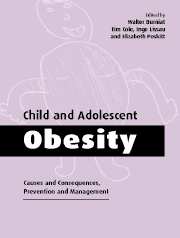Book contents
- Frontmatter
- Contents
- List of contributors
- Foreword
- Preface
- Part I Causes
- Part II Consequences
- 7 Clinical features, adverse effects and outcome
- 8 The obese adolescent
- 9 Prader–Willi and other syndromes
- 10 Hormonal and metabolic changes
- 11 Risk of cardiovascular complications
- Part III Prevention and management
- Index
10 - Hormonal and metabolic changes
Published online by Cambridge University Press: 02 November 2009
- Frontmatter
- Contents
- List of contributors
- Foreword
- Preface
- Part I Causes
- Part II Consequences
- 7 Clinical features, adverse effects and outcome
- 8 The obese adolescent
- 9 Prader–Willi and other syndromes
- 10 Hormonal and metabolic changes
- 11 Risk of cardiovascular complications
- Part III Prevention and management
- Index
Summary
Introduction
The majority of children who are obese have no underlying medical problems which are recognized as contributing to their obesity. Less than 1% of childhood obesity is caused by endocrine disease. In spite of this, in a hospital-based obesity clinic the referral diagnosis of Cushing syndrome in relatively short children with simple obesity, particularly when they develop pale pink striae of rapid fat accretion, is not uncommon. The contrast between the large body size and the small genitalia hidden in the abdominal fat can be very disturbing for obese boys and their parents consequently seek medical advice because of suspected hypogonadism. In most of the cases, after a careful physical examination, we can reassure the patient, the family and the doctor referring the child to our clinics that no hormonal abnormalities are present. Normal or tall stature, normal intelligence, normal blood pressure, normal or slightly advanced bone age and the absence of dysmorphic features more or less exclude the possibility of pathologic obesity, although the recently described single obesity gene mutations in humans have to be kept in mind. Endocrine abnormalities secondary to increased fat mass are common in simple obesity (Table 10.1), but most abnormalities disappear with successful weight reduction. Hormonal evaluation is seldom indicated unless the diagnosis of simple obesity is uncertain.
The present chapter discusses hormonal changes associated with obesity which are not necessarily abnormal or even dysfunctional. Many of them are compensatory and physiological.
- Type
- Chapter
- Information
- Child and Adolescent ObesityCauses and Consequences, Prevention and Management, pp. 189 - 220Publisher: Cambridge University PressPrint publication year: 2002
- 4
- Cited by



